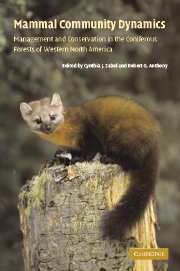 Mammal Community Dynamics
Mammal Community Dynamics Published online by Cambridge University Press: 15 December 2009
Introduction
Forests and woodlands of western North America vary from massive redwood stands with lush herb and shrub understories to scattered juniper in near-desert environments; from pine and oak stands characteristic of semi-tropical Mexico to wind-blasted spruce on coastal headlands and isolated tree patches in Arctic tundra. Disturbance (including human activities), stand development, and succession create additional variation in each forest and woodland environment. Wildfire visits some environments infrequently, if ever, while others experience under-burns every 5–20 years. Boreal and moist coastal forests continuously blanket hundreds of thousands or millions of hectares while mountain tops in the Great Basin support a few hectares of trees kilometers from their nearest neighbors. Such tremendous forest variability provides habitat for a large number of mammal species. This chapter describes forests and woodlands, focusing on mature and older conditions, from the western edge of the Great Plains to the Pacific Ocean in Canada and the United States (Fig. 2.1). Discussion is organized using the geographic regions from Bailey (1995, 1998) aggregated to resemble ecological regions described by Barbour and Billings (2000). Readers interested in discussion of the causal environmental factors associated with plant community distribution should consult Bailey (1995, 1998) and Chabot and Mooney (1985).
For the purposes of this discussion, forests are composed of trees with crowns overlapping, generally producing ≥60% vertically projected canopy cover (Anderson et al. 1998). Closed forests generally have ≥75% canopy cover.
To save this book to your Kindle, first ensure [email protected] is added to your Approved Personal Document E-mail List under your Personal Document Settings on the Manage Your Content and Devices page of your Amazon account. Then enter the ‘name’ part of your Kindle email address below. Find out more about saving to your Kindle.
Note you can select to save to either the @free.kindle.com or @kindle.com variations. ‘@free.kindle.com’ emails are free but can only be saved to your device when it is connected to wi-fi. ‘@kindle.com’ emails can be delivered even when you are not connected to wi-fi, but note that service fees apply.
Find out more about the Kindle Personal Document Service.
To save content items to your account, please confirm that you agree to abide by our usage policies. If this is the first time you use this feature, you will be asked to authorise Cambridge Core to connect with your account. Find out more about saving content to Dropbox.
To save content items to your account, please confirm that you agree to abide by our usage policies. If this is the first time you use this feature, you will be asked to authorise Cambridge Core to connect with your account. Find out more about saving content to Google Drive.